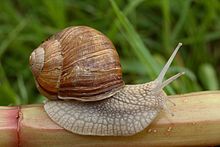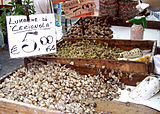Helix pomatia
| Roman snail | |
|---|---|

| |
| Helix pomatia | |
| Scientific classification | |
| Kingdom: | |
| Phylum: | |
| Class: | |
| Superfamily: | |
| (unranked): | clade Heterobranchia
informal group Pulmonata |
| Family: | |
| Genus: | |
| Species: | H. pomatia
|
| Binomial name | |
| Helix pomatia Linnaeus, 1758
| |
Helix pomatia, common names the Burgundy snail, Roman snail, edible snail or escargot, is a species of large, edible, air-breathing land snail, a terrestrial pulmonate gastropod mollusk in the family Helicidae.
This species is frequently farmed, and is called by the French name escargot when it is used in cooking.
Reproduction and life cycle
This type of snail is hermaphroditic, thus they have little trouble selecting mates. They breed from two to six times per year, and produce from eight to thirty offspring. The gestation period ranges from three to four weeks. They reach their full sexual maturity at two to four years. There are ultimately five steps of mating:
- With their heads up, snails circle each other and feel one another with their tentacles.
- After becoming stimulated, one of the snails injects a calcareous “love-dart” into the sole of the other snail. Once it becomes exhausted, the other snail does the same thing.
- After resting, they align in such a way that their genital openings overlap. This act further stimulates the snails.
- The two snails twist their bodies around one another so that the penis and vagina are connected. One snail receives a spermatophore in a process that takes four to seven minutes.
- In the final stage, the penis is removed. However, the two snails can remain attached with their feet together for several hours. [1]


During estivation or hibernation this species creates a calcareous epiphragm in order to seal the opening of the shell.
The size of the egg is 8.6 × 7.2 mm.[2]
Distribution
This species is not listed in IUCN red list, not evaluated (NE)[3] It is mentioned in annex V of Habitats Directive.
It occurs in countries and islands including:
- Austria
- Belgium
- Denmark - Listed as a protected species.
- The Czech Republic - least concern species (LC). Its Conservation status in 2004-2006 is favourable (FV) in report for European commission in accordance with Habitats Directive.[4]
- France - in eastern France
- Italy - in northern Italy
- Germany - Listed as specially protected species in annex 1 in Bundesartenschutzverordnung.
- Central and southern parts of Sweden, Norway and Finland, in isolated and relatively small populations. It is not native to these countries but is likely to have been imported by monks from Southern Europe during medieval times.
- Switzerland
- Hungary
- Netherlands [5]
- Poland
- Russia in the western part
- Slovakia
- Slovenia
- Ukraine
- Balkans
- Baltic Countries
- England, southern areas on chalk. It is not native to the British Isles. It was introduced to the British Isles by the Romans during the Roman period (AD 43-410); its common name in the UK is Roman snail. In England only (not the rest of the UK) the Roman snail is a protected species under the Wildlife and Countryside Act 1981, making it illegal to kill, injure, collect or sell Roman snails.[6]
References
- ^ [1]
- ^ Heller J.: Life History Strategies. in Barker G. M. (ed.): The biology of terrestrial molluscs. CABI Publishing, Oxon, UK, 2001, ISBN 0-85199-318-4. 1-146, cited page: 428.
- ^ 2006 IUCN Red List of Threatened Species. <www.iucnredlist.org>. Cited 2 April 2007.
- ^ Dušek J., Hošek M. & Kolářová J. (2007) Hodnotící zpráva o stavu z hlediska ochrany evropsky významných druhů a typů přírodních stanovišť v České republice za rok 2004-2006. - Ochrana přírody, 62(5): appendix 5:I-IV. (in Czech language)
- ^ http://www.anemoon.org/anm/voorlopige-kaarten/landmollusken/wetenschappelijk/helix-pomatia
- ^ [2]

